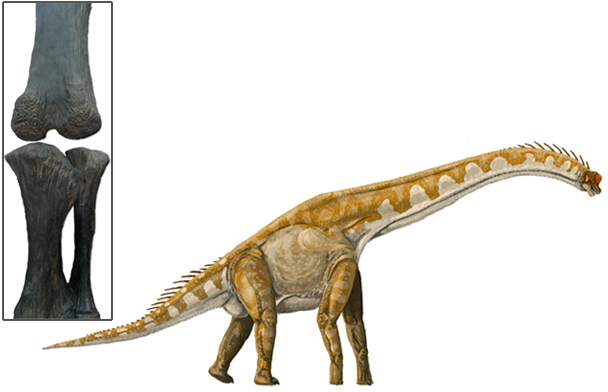Science News
Growing Dinosaurs
October 4, 2010

Last week, dinosaurs grew—some just a bit, others, like Brachiosaurus, quite a lot.
That’s because researchers, publishing in the open access journal, PLoS ONE, found that dinosaurs had thick layers of cartilage in their leg joints, sometimes increasing their average height by 10%.
Science Now explains the research this way:
Cartilage and other soft tissues generally do not survive fossilization, so in the new study researchers compared dinosaur bones to castings of the dissected bones and joints of alligators and ostriches.
Here’s the scoop: Dinosaur bones are different than the bones of mammals, including humans. Mammals have small protrusions at the end of each bone that help connect the bone with another bone at a joint, like two puzzle pieces. The bones are linked by a very thin layer of cartilage, which provides padding in the joint, but often wears down leading to painful conditions like arthritis.
Comparatively, dinosaur bones have rounded ends and no obvious way to connect one bone to another. Soft tissue structures like cartilage and muscles leave marks on bones, which enable paleontologists to make sophisticated determinations about a dinosaur's physical attributes.
Alligators have smooth, rounded bones while young ostriches have rough surfaces on their bones that mark where blood vessels feed large cartilaginous structures in the joints. Both characteristics are similar to dinosaur bones.
The research team dissected the alligator and ostrich bones and made casts of the bones with cartilage. The team then removed the cartilage and compared the bones to the casts. The bones without the cartilage were 4 to 10 percent smaller. From the evidence, the scientists concluded that certain dinosaurs had a significant amount of cartilage, and thus, were taller than original estimates.
All dinosaurs were not created equal: many theropod dinosaurs, such as Tyrannosaurus, were only modestly taller whereas ornthischian and sauropod dinosaurs, such as Triceratops and Brachiosaurus, may have been 10 percent taller or more. For example, Brachiosaurus, previously thought to be 42 feet tall, may actually have been more than a foot taller with the additional joint cartilages. Yikes!
And this new finding may lead to new discoveries. According to Casey Holliday, lead author of the study, the new dinosaur sizes could also mean a faster or slower animal, depending on how it affects the skeleton. He also mentions that “This study offers new data into how and why reptiles, and mammals, such as humans, build their joints with such different amounts of bone and cartilage.”
Dinosaur science: reaching new heights!